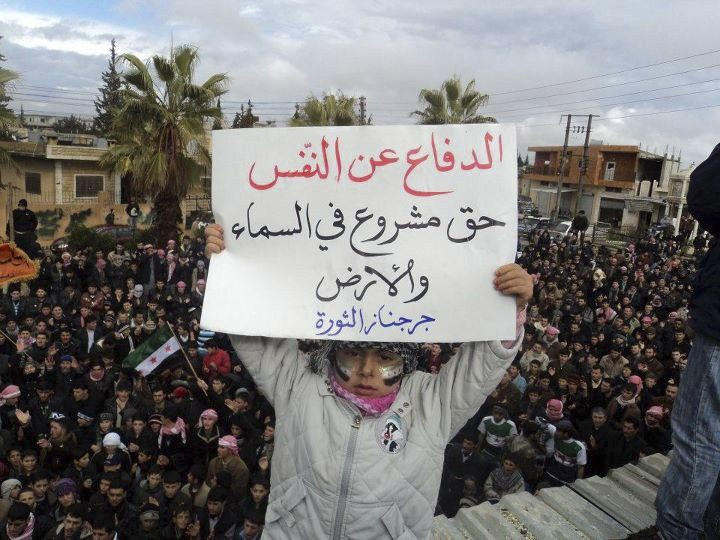Syrian Protesters Mark 30th Anniversary of Hama Massacre

Defying a government crackdown, Syrians have marked the 30th anniversary of the Hama massacre, one of the bloodiest events in recent Middle Eastern history.
According to reports, state security forces killed at least 28 people Friday who were commemorating the Hama tragedy.
Under the banner Hama, forgive us, protesters called for Syrians to march in honor of the victims of the 1982 horror by dressing in the mourning color of black and marching.
While the recent violence used by state security forces has been disturbing and widely condemned by leaders around the world – the level of the murderous fury in Syria does not approach the notorious Hama massacre of 1982.
In February 1982, the Baathist regime of Hafez al-Assad (the father of Syria’s current president) sent troops into Hama, an agricultural town in the eastern part of the country, to stamp out a revolt by the Muslim Brotherhood and the local Sunni Muslim community.
Assad and most of his allies were from the minority Shia Alawaites – considered apostates by the conservative Brotherhood.
The clash between the secular nationalist Baathists and the Brotherhood dated all the way back to 1940.
Shortly after Hafez seized power in Syria in a coup in 1963, Muslim insurgents in Hama rioted and fought with government soldiers, leading to the deaths of at least 70 Muslim Brotherhood members.
Then there was a period of relative peace between the Islamists and Assad’s regime, until the mid-1970s.
The Brotherhood and Sunni Muslim allies started a serious campaign against Assad’s Baathist regime in 1976. For the next six years, the Brotherhood committed terrorist acts against the government and its representatives, both military and civilians. By 1979, the Islamic insurgency almost caused a full-scale civil war as the Brotherhood embarked on guerilla warfare against the state.
In June 1979, scores of Alawaite military cadets were killed in Aleppo. The following year saw a spate of car bomb attacks that killed hundreds in Damascus.
By July 1980, the Baath government declared membership in the Brotherhood to be a crime punishable by death.
Still, in the early 1980s, the Brother and other Islamic factions fought an on-again, off-again war against Hafez, which include periodic bomb attacks against regime figures, At one point Hafez himself was almost killed in an attack – which led to the executions of hundreds of imprisoned Brotherhood members.
However, nothing could compare with what happened in February 1982, when decades of fighting between the Assad regime and the Brotherhood came to a shattering climax in Hama.
Hafez ordered his younger brother Rifaat al-Assad and the army to implement a “scorched earth” policy on Hama, which was a stronghold of the Brotherhood, after local Islamists called for a jihad against the state and attacked government officials.
Assad took quick and decisive revenge – troops under the command of Rifaat engineered a siege of the city and laid it to waste with heavy artillery fire and bombardments.
It is believed that up to 40,000 people (the vast majority of whom were civilians, including women, children and the elderly), were murdered en masse in one of the most horrific acts of state-sponsored violence of recent times.
There were also unconfirmed reports that the military released cyanide gas into the city in order to kill anyone who has somehow survived the initial onslaught.
About 1,000 Syrian soldiers were also killed in the operation, which destroyed large portions of the old city.
One commentator, Robin Wright, author of the book “Dreams and Shadows: The Future of the Middle East,” described the Hama operation as one of the single deadliest acts by any Arab government against its own people in the modern Middle East.
The massacre destroyed the Brotherhood for good, sending many of its leaders to exile. The insurgents were particularly dismayed that no other Sunni Muslim groups around the country joined their “holy war” against Assad in solidarity with the people of Hama.
The horrors of Hama have had a long-lasting impact on Syrians and Arab peoples as a whole
Fouad Ajami of Johns Hopkins University once told PBS: “In many ways you can look at the Arab world over the last few decades and really if you want a turning point, I think the turning point was the terror unleashed on the Syrian people in the city of Hama in 1982. For about 25 years the Arab people have been terrified of their rulers… [and they] have really marginalized them and demolished their sense of dignity.”
Hafez died in 2000, when his son Bashar took over as President. It remains to be seen if the continuing unrest in Syria will ultimately lead the Assad regime to unleash the kind of wholesale violence on the populace as they did in Hama.
New York Times columnist Thomas Friedman warned a few years ago: “When Syria's Baath regime feels its back up against the wall, it always resorts to ‘Hama Rules.’ Hama Rules is a term I coined after the Syrian Army leveled — and I mean leveled — a portion of its own city, Hama, to put down a rebellion by Sunni Muslim fundamentalists there in 1982.”
© Copyright IBTimes 2024. All rights reserved.











